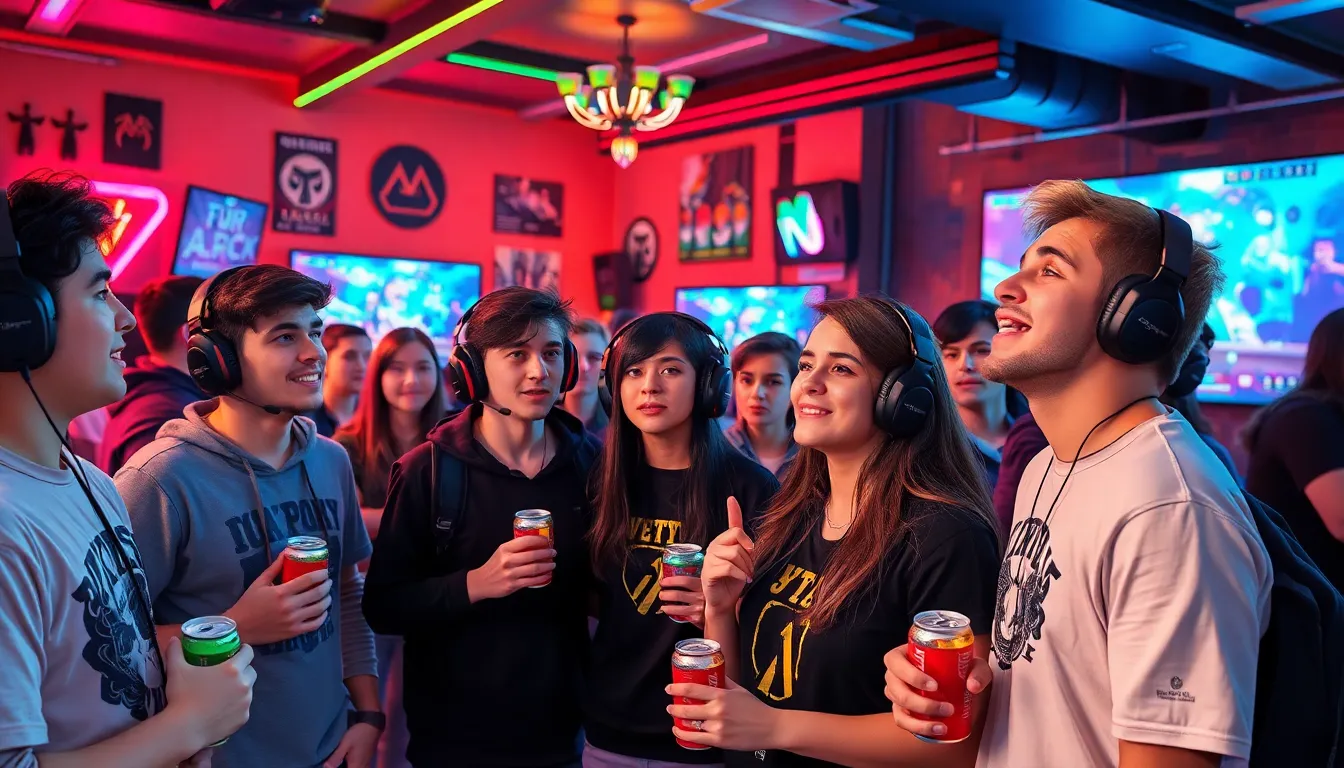The world of esports isn’t just about gaming; it’s a cultural phenomenon that’s taken the globe by storm. With millions glued to their screens, cheering on their favorite teams, esports fans have become a force to be reckoned with. They’re not just spectators; they’re passionate advocates, meme creators, and sometimes, even armchair coaches yelling at their monitors.
Table of Contents
ToggleOverview Of Esports Fan Base
Esports fans represent a diverse and global community, exhibiting a range of demographics that span age, gender, and geographic location. In 2023, approximately 500 million people engage with esports worldwide, with an expected growth rate of 10% annually. Younger audiences dominate this landscape, as studies show that 70% of esports viewers are under 35 years old.
Community engagement plays a crucial role in the fan experience. Many fans participate in online forums and social media platforms, sharing game strategies, creating memes, and discussing team performance. Active involvement fosters a sense of belonging among fans, contributing to a robust online culture.
Fan loyalty significantly influences esports teams and events. Research indicates that 80% of dedicated fans support their favorite teams through merchandise purchases and event attendance. Supporting teams creates a deep-rooted connection, enhancing overall engagement and investment in the esports ecosystem.
Sponsorship and advertising reflect the expanding commercial potential of esports. Major brands recognize the value of reaching this engaged audience, investing billions in partnerships and promotional campaigns. Such investments further legitimize esports and elevate the overall fan experience.
Streaming platforms also shape the consumption of esports content. Channels like Twitch and YouTube Gaming attract millions of viewers daily, offering them access to live events and esports broadcasts. As fans create their own content and share experiences, the community continues to grow collaboratively.
In essence, the esports fan base thrives on its dynamic, active participation in both online and offline spaces. Diverse demographics, strong community ties, loyalty to teams, and commercial investments contribute to the vibrancy of this phenomenon.
Demographics Of Esports Fans

Esports fans represent a wide-ranging demographic profile that highlights the unique characteristics of this growing community. Understanding these demographics reveals insights into fan engagement and content consumption patterns.
Age Groups
Age groups within the esports fan base are predominantly young, with 70% of viewers under 35 years old. This youthful demographic engages actively through social media and online platforms. Fans aged 18 to 24 make up a significant portion, showing high levels of participation in tournaments and events. Those aged 25 to 34 also contribute considerably, indicating a broad appeal across adults. The high concentration of younger fans facilitates the rapid growth of esports-related content, enhancing community interaction. This age dynamic enriches the overall gaming culture.
Gender Distribution
Esports boasts a diverse gender distribution, though it remains male-dominated. Recent statistics indicate that approximately 70% of the fan base identifies as male, while 30% identify as female. Growth among female viewers is noticeable, with increasing participation in gaming and competitive play. Female fans often take on roles as content creators and influencers, contributing to a more inclusive environment. These shifts highlight an evolving landscape, where both genders actively engage in community discussions and support their favorite teams. This trend fosters a wider acceptance of esports across all genders, promoting diversity.
Engagement Levels Among Fans
Esports fans engage at high levels, significantly enhancing the overall experience of the community. The ways in which they participate include their viewing habits and social media interactions.
Viewing Habits
Fans consume content through various platforms, with Twitch being a leading choice. Live streams attract millions, with viewers often tuning in for several hours at a time. Many fans prefer watching tournaments or gameplay highlights rather than traditional sports. Younger audiences, especially those under 35, favor on-demand content that allows for flexibility. Statistics show that 500 million esports fans globally engage in content, underscoring the appeal of live events. The shift from passive viewing to interactive experiences marks a key trend in how fans connect with their favorite teams.
Social Media Interaction
Interaction on social media strengthens community bonds among fans. Many fans follow teams and players on platforms like Twitter, Instagram, and TikTok, where they can share content and join discussions. Friendly rivalries often emerge through meme exchanges and comment threads surrounding matches. About 80% of dedicated fans actively participate in online conversations, enhancing their sense of belonging. Social media enables fans to connect with influencers and streamers, broadening their engagement. Gamers collaborate to create content, fostering a culture of creativity that thrives within the esports ecosystem.
Factors Influencing Esports Fan Base Growth
Esports fan base growth stems from several key factors. The rapid rise of streaming platforms significantly impacts audience engagement.
Popularity Of Streaming Platforms
Streaming platforms like Twitch and YouTube Gaming attract millions of viewers with their live content. Users connect with their favorite players and teams through interactive experiences. Real-time chats and community features enhance fan engagement. Approximately 80% of esports fans prefer to watch live streams, showcasing the importance of these platforms. Gamers also disseminate their content on these channels, fostering creativity and collaboration. Engaging broadcasts, while offering commentary and behind-the-scenes glimpses, keep audiences invested. Various streaming events create a sense of urgency, prompting fans to tune in. Overall, the popularity of streaming services plays a pivotal role in esports fan base expansion.
Impact Of Major Tournaments
Major tournaments serve as significant milestones in the esports calendar. Events like The International and the League of Legends World Championship draw massive viewership, often reaching millions. These competitions offer substantial prize pools, enhancing their allure among players and fans alike. Gamers rally around their favorite teams, deepening the emotional connection. Broadcasts of these tournaments frequently trend on social media, generating buzz and attracting new viewers. High-stakes matchups elicit intense fan engagement and discussions, creating vibrant online communities. Enhanced production value, along with expert commentary, elevates the viewing experience. Major tournaments contribute directly to the growing popularity and recognition of esports.
Regional Differences In Esports Fan Base
Esports fan bases exhibit notable regional differences, reflecting cultural and demographic variations across the globe.
North America
North America has a vibrant esports scene marked by strong fan engagement. Approximately 42% of esports fans in this region participate in events and tournaments. Popular franchises like Call of Duty and Fortnite draw massive audiences, often exceeding millions for major competitions. The presence of professional leagues, such as the Overwatch League and League of Legends Championship Series, promotes loyalty among fans. Many fans also engage with content creators on platforms like Twitch and YouTube, amplifying their connection to the esports community. Esports arenas in cities like Los Angeles and New York serve as hubs for events, fostering a spirited atmosphere that enhances fan experience.
Asia
Asia represents the largest and most diverse esports fan base globally. With a staggering 57% of the world’s esports audience hailing from Asia, this region leads in viewership and participation rates. League of Legends and Dota 2 dominate the cultural landscape, where events attract tens of thousands of live spectators and millions of online viewers. The emergence of mobile esports, particularly in countries like China and South Korea, expands accessibility to gaming events, catering to the growing number of mobile gamers. Fans actively engage in online platforms, with discussions often trending on social media. Regional tournaments in cities like Seoul and Shanghai underscore Asia’s commitment to nurturing talent and elevating the esports community on a global scale.
The esports fan base continues to evolve and expand, driven by passionate engagement and diverse demographics. As younger audiences embrace this vibrant culture, their active participation shapes the future of esports. The rise of streaming platforms and major tournaments further enhances the fan experience, creating deeper connections among supporters.
With a strong sense of community and loyalty, fans are not just passive viewers but integral parts of the esports ecosystem. As brands invest in this growing industry, the potential for further growth and inclusivity remains promising. The ongoing transformation of esports will undoubtedly keep fans engaged and excited for what’s next.

